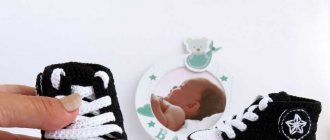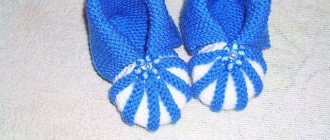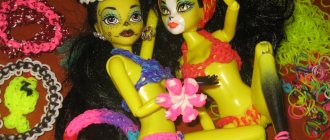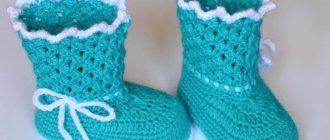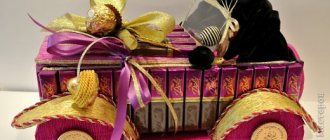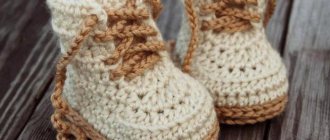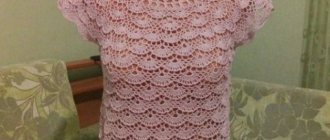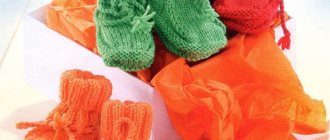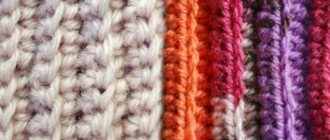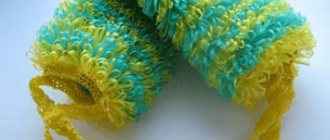Booties are the first shoes of babies, so every mother wants them to be the best. Despite the variety of finished products made of leather and textiles, knitted models for babies look especially beautiful, causing tenderness to others. And although you can always order their production from an experienced craftswoman, many mothers strive to crochet booties for their baby on their own. As you know, a thing created by loving hands and imbued with the warmth of a mother’s soul has a special energy, protecting against illnesses and unkind views. In addition, knitting with your own hands allows you to get unique children's shoes, exactly the way they are seen in your fantasies.
Yarn selection
This is an important step towards creating booties for your baby. The yarn should be soft and safe for children's health. When choosing threads, you need to pay attention to their characteristics and quality. Recommendations for selecting yarn for baby booties from experienced knitters:
- If wool is taken, it is better to give preference to merino. It has short fibers, it is soft, and the finished fabric is not itchy.
- If a child is allergic to wool thread, you can use acrylic to make simple crocheted booties. Despite the fact that this yarn is artificial, it allows you to create very soft, pleasant to the touch, beautiful products. They will wash well and not lose their appearance for a long time.
- You can safely use microfiber for knitting booties. It has the same properties as cotton, but is more flexible and does not lose its attractiveness for a long time.
- Elegant openwork models for babies can be made from yarn with viscose or silk. The finished products will be pleasant to the touch and quite wear-resistant.
- Soft and fluffy slippers made from plush threads or yarn imitating fur will give your child warmth and comfort. Such materials will serve as an excellent basis for winter footwear.
Models for summer are well knitted from cotton or thin acrylic threads. These booties will be light, cool, and will allow children’s feet to breathe and sweat less. To make warm products, thick acrylic yarn, wool, or a mixture of both materials are most often used, which warms well in cold weather.
It is not recommended to use the following types of yarn for knitting children's slippers:
- Angora. It has long fibers that will stick to the baby's hands and can get into the mouth.
- Yarn with lurex. Metallic thread will chafe or even injure your baby's delicate skin.
If the choice falls on wool or cotton, you should take into account some nuances. Woolen products can provoke allergic reactions; they can prick, creating discomfort. After washing, cotton may shrink slightly in size and become stiff, so it is better to knit summer items from thin acrylic. The threads should not be tightly twisted.
As for shades, it is recommended to choose yarn in soft pastel colors. It is better not to buy threads with poisonously bright dyes; they not only fade, staining the baby’s skin, but also negatively affect children’s health. For girls, they usually choose soft pink, lilac, mint, golden threads, for boys - blue, green, gray, brown.
Merino wool Acrylic
Microfiber
Viscose
Yarn with silk
Fur
Cotton
Successful color combinations and decor
The colors of the booties are chosen by parents. Experts recommend avoiding too bright, irritating shades. The coloring compounds used can provoke an allergic reaction. In addition, children perceive the world around them differently than adults. Harsh tones: red, burgundy, black, negatively affect the development of the child.
According to psychologists, delicate green, orange, yellow, blue and other natural colors are considered the best for children. They lift your spirits, charge you with positivity and just look cute.
Modern children's fashion has long moved away from the standard idea that knitted shoes for a boy should be blue, and for a girl - pink. Although some parents stick to the classic palette. Now other color combinations are trending: gray and white and their combinations with yellow, turquoise, and orange accents. For boys, purple, sapphire, azure, emerald, and cornflower blue shades are often chosen. For girls, scarlet, carrot, peach tones. Lemon, beige, and all pastel colors are considered universal.
Children's shoes knitted with knitting needles are decorated with buboes, openwork knitting, and braids. Decorations in the form of embroidery, ruffles, appliqués, buttons, satin ribbons, beads, pompoms, lacing and other elements look attractive.
However, it is important that the design of the models is laconic, with a minimum amount of decoration. All elements must be securely fastened, because small children have a habit of putting any objects in their mouths. Torn parts may enter the child's respiratory tract. Before trying on boots, you need to carefully check the strength of the fittings.
READ ALSO: Crochet for newborns: kit for a boy or girl, materials and patterns
Required Tools
Having selected the yarn to crochet booties for a newborn, you also need to prepare the tool itself. Its length should not exceed 15 cm, otherwise it will be inconvenient for them to work. The size of the hook depends on the thickness of the selected thread:
- acrylic – 1.6;
- microfiber – 1.5-2.5;
- cotton – 1.5-2.
The thicker the yarn, the smaller the hook needed. In this case, the shape of the booties will be tight, and all bends and curves will be clear.
Additionally, the craftswoman may need tapestry needles for stitching parts and attaching decorative elements. Inexperienced knitters will find markers in the form of plastic rings useful - they can be used to mark rows.
Seamless boots
When a child learns to walk, it is necessary that nothing interferes. Seamless booties are suitable for such cases. Many products require sewing parts, but there are models that are made using a seamless technique. Most often this is done using knitting needles.
This is not a difficult job, and if you wish, you can master this method.
How to take measurements
Before starting work, be sure to take measurements. Each baby has its own body type, so the length and fullness of the feet may differ among children of the same age. There are patterns for crocheting booties for beginners. To build them correctly, you will need measurements of the child's leg.
The main measurement is foot length. You can get it by applying a ruler from the most protruding point of the heel to the extreme point of the big toe. In addition to the results obtained, you need to add 1-3 cm. The volume of the leg is determined by the circumference of the widest part of the foot. The girth of the lower leg is measured immediately above the two protruding bones, placing the measuring tape tightly against the leg. When recording measurements, you need to take seam allowances into account.
If taking measurements is a problem for beginner bootie knitters, you can use a ready-made table.
| Age, months | Foot length, cm |
| 0-3 | 8-9 |
| 3-6 | 9-10 |
| 6-8 | 11 |
| 8-10 | 12 |
| 10-12 | 13 |
| Before 18 | 13-14 |
Wearing any booties, crocheted, textile or leather, is recommended for babies who are not yet walking. This model does not have a hard sole, so constant walking in it will lead to the development of flat feet.
Since booties imitate shoes, they are not worn on a naked body, so they need to be knitted in such a way that they can be worn freely over tights or a light jumpsuit. It is better to make the top elastic; you can attach a clasp or ties.
Stages of knitting classic booties
Knitted booties consist of several parts: toe, sole, sides and upper part. Each of them is made according to certain rules. Warm booties are more like small boots, and summer ones are more like socks.
Sole
If the child is chubby, we crochet booties on an oval sole. It should not be narrowed in the toe or heel area. You can use this example, described step by step for beginners:
- First, a chain is made of 12 VP (chain loops) and an additional 3 lifting loops (for knitting double crochets - CH).
- In the third loop from the edge you need to start knitting CH (10 pieces). Next, 7 CH are knitted into the last VP. After this, you need to make another 10 dc. In the first VP, 6 CH and a connecting stitch are knitted.
- The new row begins with 3 lifting loops and 11 dc. For rounding, 2 dc are knitted into each previous stitch. All steps should be repeated 5 times.
- Next, 12 dc are knitted in a row, after which the rounding is repeated again, as at the beginning of the row (2 dc in the previous column, repeat 5 times). The row ends with a connecting column.
- The next circle begins with 3 lifting loops, continues 13 dc. The rounding is done as in the previous row, but knitting the stitches is repeated 6 times.
- Next you need to make 16 dc, a rounding, another 2 dc and a connecting stitch in the last lifting loop.
The length of such a sole is 11 cm, and the width is 6. If you need to reduce the size, you can change the number of circular rows. Instead of double crochets, you can use single crochets. To adjust the size, you should also reduce or increase the number of air loops in the chain.
Once the sole is completed, you can begin knitting the sides. This should be done behind the back half-loop of the column of the previous row. Depending on the volume of the foot, 2-3 rows of dc are knitted along the edge of the sole. There is no need to make any increases or decreases.
Toe
Depending on the design, this part may have a different shape: pointed or rounded. If an inexperienced craftswoman is trying to learn how to knit booties, to make the task easier, it is better to make the toe separately and then sew it on. Patterns and descriptions of knitting this part of the bootie are offered below:
- Row 1. You need to dial 5 VP. Next, 3 lifting loops are made, 5 dc, and then a rounding (2 dc are knitted into each column of the previous row 7 times) and 6 dc.
- Row 2. It is knitted in the same way as the first, but to round it you need to knit 2 dc in each column of the previous row, repeating the procedure 7 times.
- The final row. It is made in the same way as the previous one, but for rounding, knitting the stitches is repeated 14 times.
In order to attach the toe to the sides, you can use connecting posts.
The seam should face outward so as not to rub the baby's delicate fingers.
Bootie top
Patterns for crocheted booties can be different, depending on the model of the product. Most often, such shoes are made with a shaft. The diameter of the upper part is equal to half the length of the foot. The knitted fabric can be solid and made from double crochets or single crochets, or it can become the basis for decorative elements (mesh).
To crochet booties for a boy, a regular lapel will do. Most often, double crochet is used to knit the top. No subtractions or additions are required. For ease of putting on, and also to prevent the shoes from slipping, there should be ties on the top, and holes in the fabric are provided for them. The knitting pattern will be as follows: 2 dc, 2 ch. This rapport needs to be repeated only 1 time, after which a solid canvas is made.
To make the shin look elegant, you can use “tick” posts. From the previous column of the first row, knit 1 dc, 1 ch, 1 dc. In the next rows this combination is knitted from an air loop.
Decoration
The model in the form of openwork crocheted booties is more suitable for girls. In addition, the product can be decorated to your liking. The most common options are:
- Knitted appliques. There is complete freedom of imagination - butterflies, hearts, flowers. The applique is attached with the same threads from which it was knitted. The stitches are pulled through the toe and the decorative element.
- Satin bows and ribbons.
- Openwork binding of the sole and lapel.
It is important to remember that any decorative elements must be sewn firmly so that the baby cannot tear them off. They should also not contain small parts so that a child cannot swallow them.
Manufacturing nuances taking into account the model
Having figured out how to knit basic booties for a newborn, you can try to complicate the task. After the model of the future product has been selected, you will definitely need a knitting pattern with a description; it would also be a good idea to watch a master class on the topic. This is the only way for beginning craftswomen to cope with the task.
Openwork
These are perhaps the most popular booties for girls. They consist of the same parts as standard products. Most often, thin acrylic threads and a 1.5 hook are used for making. After the sole is made, you can begin making the sides. Here the first row is knitted with a BN stitch without increasing or decreasing. In this case, the grip is made by the column of the previous row.
Next, the sock is formed. Lastly, the cuff is knitted; its step-by-step description is presented below:
- Row 1. Requires 3 lifting stitches, after which you need to knit a dc in the round. When moving from the toe to the shaft in the side part, you need to make 2 dc. The row ends with a connecting loop.
- Row 2: 3 lifting loops, after which 1 VP and 1 CH are repeated until the end of the row.
- Row 3: The entire circle is worked in DC stitches.
- Row 4: Repeat row 2.
In such products, the instep can be made standard, and the toe and top can be openwork. When working, you need to take into account that such models practically do not stretch.
Booties for girls
Knitted lightweight shoes are also perfect for your baby. They are useful for everyday wear or special occasions, depending on the availability of decor and its features. Yarn for work should be soft and pleasant to the touch.
First you need to knit the sole; it is done according to the standard pattern. After this, small sides are made. Just 2 rows are enough. Next, you can start knitting the strap. To do this you need to score 20 VP. In the 4th loop from the hook side you need to make 1 dc. After this, you need to make 2 VP, in the 3rd and 4th loops of the chain - 1 CH, again 2 VP. To the end of the row you should knit double crochets. Once the product is completed, you can begin finishing it as you wish.
Ballet booties
To make such crocheted booties for newborns, you can take a diagram of ballet shoes with a detailed description. They differ from other models in that they do not have a boot and are more like slippers. Instead of a toe, it is allowed to use decorative crocheted elements.
To ensure that the product fits well on the leg, it is advisable to use elastic yarn containing elastane. Ballet shoes can be decorated with knitted or decorative elements. A laconic design is available upon request.
Sneakers
For a boy, you can crochet booties in the form of fashionable sneakers. They look very elegant and original. Typically, threads of several shades are used for manufacturing. Products must be knitted in half-columns or sc (single crochet), in which case they will hold their shape well. When making booties, you need to consider the following nuances:
- The sole is made according to the usual pattern; light yarn is used for the work. After completing the element, the thread must be secured and cut.
- To make the rise you will need yarn of the main shade. It is necessary to take into account that the first row should be perpendicular to the sole. This will bring the model as close as possible to real shoes.
- To knit a toe, a basic pattern is required.
- Next, pick up and knit the loops of the front part of the product, which will form the tongue. The base of the sneaker must be made so that it overlaps the side of the toe. In this case, the sides should touch each other, this creates the effect of a real fastener.
- Lastly, the laces are knitted. Here it is enough to use a chain of VPs. The length is adjustable as desired. Instead of laces, you can take thin satin ribbons, which will match the color of the main part of the sneakers. To fix them, the sides of the fabric are knitted with holes along the edges.
To decorate such shoes, you can embroider the logo of some popular brand.
Booties
This is the best shoe option for children in the cold season. To make this model you will need two shades of yarn. It is better to use tool number 2.5. Crochet process step by step:
- Making the sole (length – 9 cm). First you need to collect 15 VP. Next, 2 dc are performed in the 4th ch, after which 10 dc are knitted into each subsequent loop. In the last VP you need to perform 6 dc. The remaining 10 dc are worked symmetrically. In the same loop in which the first 2 dc were made, you need to knit another 3 dc. Further rows are performed similarly. As for the rounding, in this area you need to knit 2 dc in each column of the previous row. You need to close the rows using 1 SP (connecting loop).
- Sides. They need to be performed as RLS. No subtractions or additions are required. We crochet 3-4 rows - it all depends on the volume of the foot. To round the front part, you need to decrease the loops several times.
- Boot top. The upper part is knitted with dense fabric. Double crochets or single crochets can be used here. To connect the loops of each row, 1 joint venture is required. To start the row you will need 3 VPs.
To prevent the boots from slipping off the child’s feet, you need to thread a lace between the shin and the bottom. Some craftswomen sew on an elastic band, but it is worth considering that it can put pressure on the ankle, causing discomfort to the baby.
In the form of animals
Especially beautiful crocheted booties that imitate the faces of animals. Here you will need fancy yarn: textured, “grass”. All options use basic schemes. The main emphasis is on the finishing of the product. There are no strict rules for making booties - it all depends on the imagination of the craftswoman. The most popular options:
- "Hedgehogs". To make it, you will need grass-type threads with long pile. The color can be black or dark brown. To highlight the hedgehog's nose and eyes, you should use voluminous knitting or embroidery; buttons will be dangerous for small children. Usually only the upper part is done with “grass”; for the lower part you can use acrylic.
- "Crocodiles." A characteristic feature of the product is a special “scale” pattern used to make the boot. To knit the warp, standard double crochet stitches are used.
- "Bears." These booties made from plush threads will look impressive. Ears and muzzle elements are sewn on the toe. To make the nose look more voluminous, you can put padding polyester underneath it.
- "Minions". They are knitted like regular booties. To work you need threads of yellow, black and blue colors. To complement the look, you can add contrasting trim along the edge of the sole.
Crocheting booties in the shape of animals is easy. With a little effort and imagination, you can make original shoes for babies that can be worn not only at home, but also for walks.
"Hedgehogs"
"Crocodiles"
"Bears"
"Minions"
Manufacturing algorithm
By creating boots yourself, you can get unique products with an original design that fully correspond to the size of your child’s feet. With the help of a detailed master class, any woman can make beautiful booties. They are knitted and crocheted, sewn from fabrics and fur.
READ ALSO: 25 knitted hooded patterns for children and adults, Knitting patterns
Knitting needles
To knit booties with knitting needles you will need:
- 25–30 g of yarn, suitable for making children's clothes;
- stocking needles No. 2.5 – 3;
- hook No. 2.5;
- large needle for stitching elements.
You must act according to the following algorithm:
- Cast on 8 stitches and 2 edge stitches on two knitting needles.
- The first row is knitted in stockinette stitch without adding stitches. In the second, new ones are added. You should follow the knitting pattern for boots.
- With straight fabric you need to knit the number of rows corresponding to the length of the foot.
- For the side walls, 14 loops are cast on, for the heel - 8.
- 13 rows are knitted in stockinette stitch in the round.
- The toe is closed by removing the loops on both sides.
- Crochet 100 air loops.
- The resulting lace is inserted into the holes on the shoe and tied with a bow.
The second product is made in a similar way. You can decorate booties with beads, ribbons, and buttons. It is important to carefully secure all decorative elements.
Crochet
To crochet booties you will need:
The product is knitted as follows:
- Work begins with creating the sole. To do this, assemble a chain of 10 air loops + 3 lifting loops.
- On the 5th loop from the beginning, a double crochet is knitted. Next, the chain is tied on both sides in exactly the same way 4 times.
- When moving to the sides, row 1 is knitted with single crochet stitches, wrapping around each stitch of the previous row.
- To create a border, you need to knit 3 rows of single crochet stitches; there is no need to add loops, this strengthens the shoes and gives them shape.
- The toe consists of 4 rows, knitted according to the pattern.
- A cuff is made, which is then tied around the perimeter with white yarn along with the toe.
- A satin ribbon is inserted into the booties.
Even beginner craftswomen can crochet beautiful shoes. To do this, you must strictly follow the presented diagram and description of the work. You can decorate the finished product with ribbons, bows, and appliqués.
From fabric
To sew your own boots, you will need two types of fabric: cotton for the base and felt for the insole. In addition, the following tools and materials are needed:
- sewing machine;
- scissors;
- threads;
- needle;
- fabric marker;
- pin;
- ribbons;
- beads.
- You can take any patterns for sewing booties. They are outlined on the fabric with a marker, then cut out along the contour.
- The center of each element is marked so that there is no displacement when stitching.
- The parts are applied to each other so that the center lines coincide, basted and stitched on the machine.
- The same actions are carried out with the base and insole.
- After stitching, the base and lining are joined.
- As decoration, the top of the product is trimmed with ribbons and beads.
- The finished shoes are washed to remove marks from the marker.
When making shoes from fur, it is necessary to take into account the direction of the pile and arrange all the elements equally, otherwise the booties will take on a sloppy appearance. When stitching felt, threads of medium thickness are used. Too thin ones tear the edges of the material, thick ones leave large holes.
Booties are the first shoes of a newborn baby. It should be safe, comfortable, soft and attractive. When choosing or making your own, be sure to take into account the size of the leg, color, and seasonality.
Beautiful and safe decor
Even the simplest crocheted booties can be made unique and original if you use bright decorative elements. But they must be as safe as possible in size and material of manufacture. The component must not cause injury to the baby. It is not allowed to use beads or buttons for the design, but multi-colored ribbons and sewn or knitted appliqués are acceptable.
Gluing decorative elements is prohibited, as a child can quickly tear them off and put them in his mouth. Everything needs to be secured with threads. Pins or rivets of any kind are not permitted. For boys, you can use appliques of the appropriate theme: marine, automobile, cartoon superheroes. The satin stitch embroidery looks interesting on the booties. Ornaments can be completely different. Only threads are used, beads cannot be used. For girls, flowers and hearts are suitable as designs, for boys - ethnic motifs.
Sequins, which are popular today, should not be used for embroidery, as their sharp corners and edges can scratch the baby’s skin.
Schemes for beginners
Crocheting booties will be easier and faster if you carefully follow the patterns. To correctly decipher them, you need to know what lies behind this or that designation; the most common abbreviations are:
- VP – air loop;
- CH – double crochet;
- RLS – single crochet;
- SP – connecting loop;
- R - row.
How each of them is designated is described below:
- elongated oval - air loop;
- cross - single crochet, standardly used to increase the density of the product;
- letter T – half double crochet;
- crossed out T – double crochet;
- crossed out by two or three lines T - a column with two and three crochets;
- a cross with a loop on top - a twisted column;
- a cross with a dash on top is a connecting loop.
It is important to remember that diagrams are read from bottom to top. The rows in them are considered one by one: odd - from right to left, and even, on the contrary - from left to right, circular - always read from right to left.
Plush yarn booties
Knitting from warm plush yarn is very easy and pleasant using a hook with a diameter of 4-5 mm. Make the sole according to a simplified pattern in a circle, but you will need fewer rows due to the thickness. In the same way, use 2 lifting loops, and then knit behind the back walls of the loops.
Rise up, turn the knitting around and work half double crochets from the second stitch. Fold the bootie in half and mark the future sock with a marker - about 8 loops each. Before them, knit as before, and after the marker, start decreasing. The next 2 rows follow exactly the same pattern, only there will be half as many decreases each time.
Work 2 more rows up just in the round to form the top of the booties. Decorate the sole and edge with a thread of a different color and texture, and for volume you can take it in two folds. The neat terry decor and the same laces look interesting on the plush.
